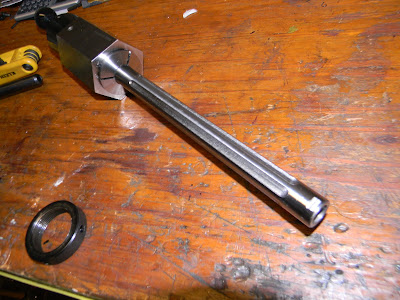
Since the action actually works, it's time to figure out a sight mount. I'd like this gun to wear a dot sight of some kind. Considered cutting 11mm dovetails into the top, but there's almost two feet of Picatinny rail in my parts box in various lengths and I'm lazy. Above is a mount from UTG (aka Leapers) that was made to fit I don't know what. But the length is about perfect.
The pink underbelly of the rail is curved. This most certainly does not fit the breech.
Just a couple passes with a milling cutter.
The radius is gone.
Cut the rail.
Trimmed and cleaned up the ends to fit the breech.
Found center and laid out the mounting hole locations. Spotted.
Drilled.
Tapped M4 x 0.7mm. Assumed that since the base was a UTG product, all the mounting hardware would be metric.
That was not the case at all. The UTG supplied fasteners didn't fit my freshly cut M4 threads. Of course, those supplied screws are sized to fit pre-existing holes in a specific gun that the rail was made for. Duh.
Lucked out and M4 socket head cap screws fit the counterbores. I had enough M4 bolts in various lengths to get by.
Test fit. The bolts will need trimmed to length.
Next, I needed a better cocking pin for the striker (hammer).
Took just a few minutes on the Taig. Used a piece of W-1 tool steel.
The small shoulder is necessary so the pin can't pull up and out of the hammer (striker).
Set all that aside and started finishing up the shroud. Chucked the muzzle end in a 5C collet.
A 5/8" 5C collet.
This is a six-sided, or "hex" collet block. It can be located in sixty degree increments.
Work goes into collet. Collet goes into block.
Elected to not use a threaded lockring and instead used a cam lock to seat the collet into the block.

This was clamped into the milling vise. Made some rough marks to establish stopping points for the cuts. Set the table stops to correspond.

Used a jack screw to support the free end of the tube. Without it, the tube would deflect downward during the cut.
0.500" ball mill.
Cut to a predetermined depth, rotate the block 60 degrees, cut to a predetermined depth...
Cut roughly three-quarters of the way through the wall thickness of the shroud.
Set the rear of the block dead even with the edge of the vise jaws. This made the starting and ending point of each flute cut the same. A work stop or vise stop can also be used to get the same result.
Six flutes cut.
More in a few days.


























